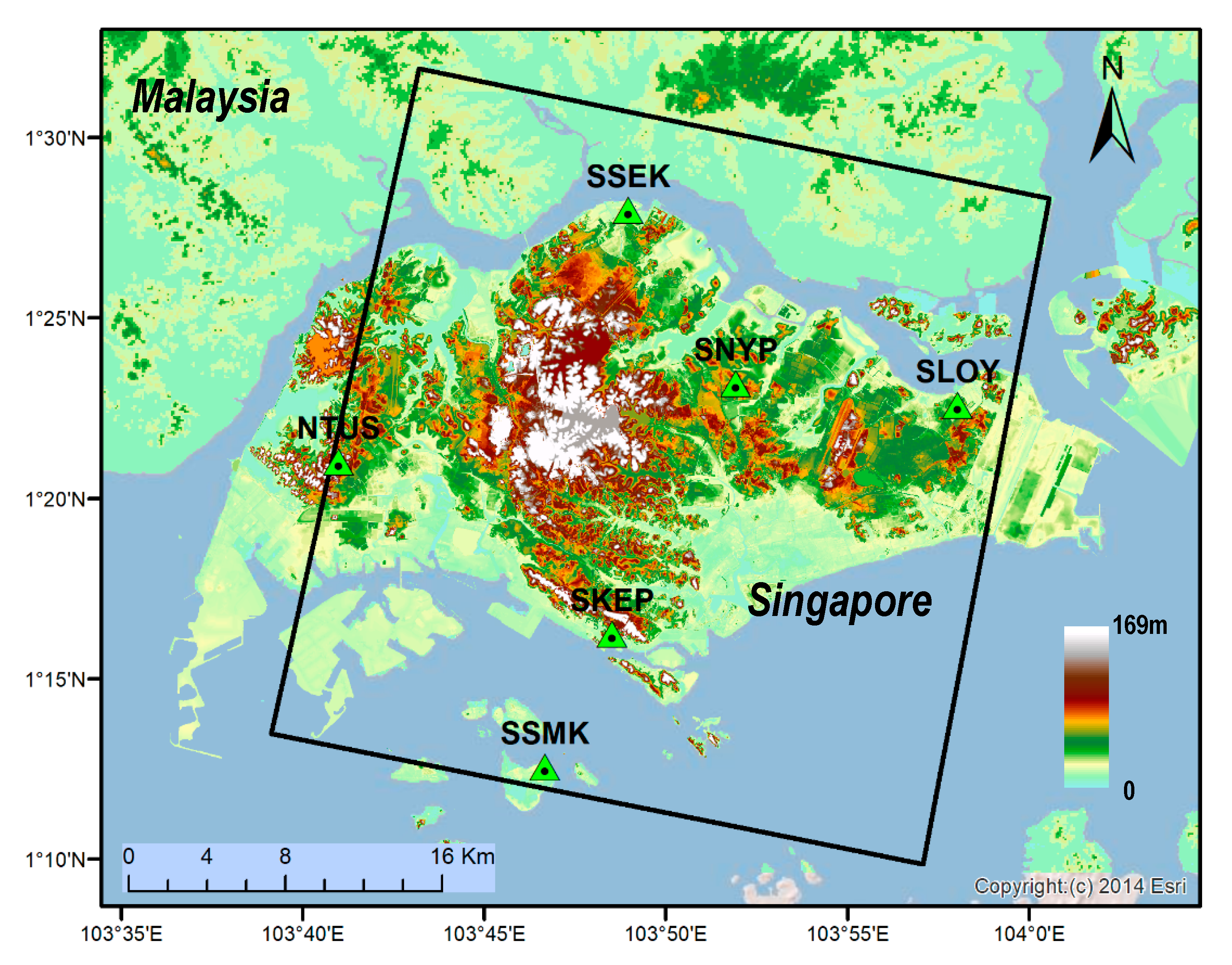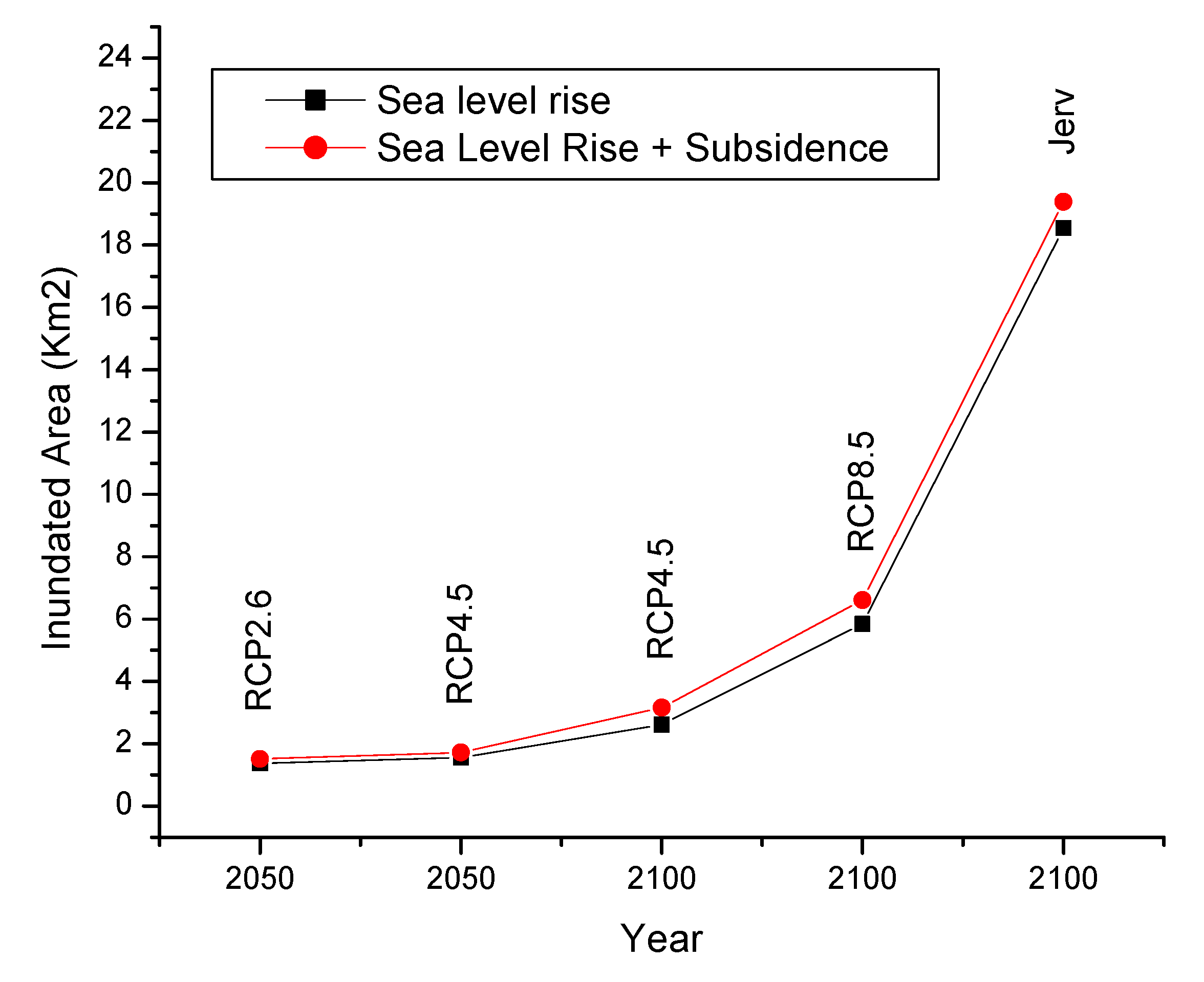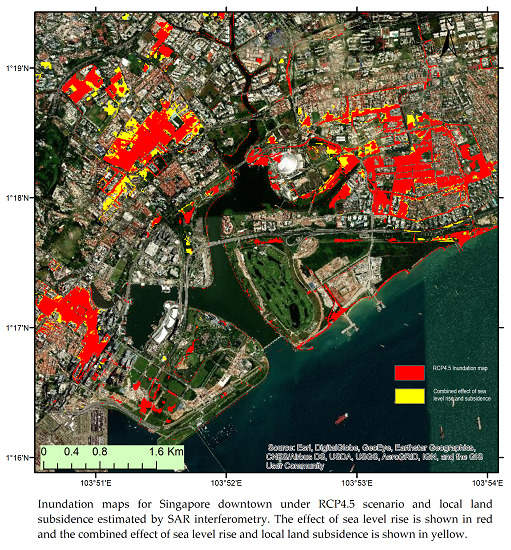Insar Maps of Land Subsidence and Sea Level Scenarios to Quantify the Flood Inundation Risk in Coastal Cities: The Case of Singapore
Abstract
:1. Introduction
2. Study Area, Geological Settings and Data
2.1. Geological Settings
2.2. Data
2.2.1. Digital Terrain Model for Singapore
2.2.2. Sar Data
3. Data Processing
4. Results and Discussion
4.1. Subsidence Results
4.2. Subsidence Modelling
4.3. Inundation Scenarios
5. Conclusions
Author Contributions
Funding
Acknowledgments
Conflicts of Interest
References
- Bijlsma, L.; Ehler, C.N.; Klein, R.J.T.; Kulshrestha, S.M.; McLean, R.F.; Mimura, N.; Nicholls, R.J.; Nurse, L.A.; Nieto, H.P.; Stakhiv, E.Z.; et al. Coastal Zones and Small Islands. In Climate Change 1995: Impacts, Adaptations and Mitigation of Climate Change: Scientific-Technical Analyses; Watson, R.T., Zinyowera, M.C., Moss, R.H., Eds.; Contribution of Working Group II to the Second Assessment Report of the Intergovernmental Panel on Climate Change; Cambridge University Press: Cambridge, UK, 1995; pp. 289–324. [Google Scholar]
- Scussolini, P.; Tran, T.V.T.; Koks, E.; Diaz-Loaiza, A.; Ho, P.L.; Lasage, R. Adaptation to Sea Level Rise: A Multidisciplinary Analysis for Ho Chi Minh City, Vietnam. Water Resour. Res. 2017. [Google Scholar] [CrossRef] [Green Version]
- Choblet, G.; Husson, L.; Bodin, T. Probabilistic Surface Reconstruction of Coastal Sea Level Rise during the Twentieth Century. J. Geophys. Res. Solid Earth 2014. [Google Scholar] [CrossRef]
- Hsieh, C.S.; Shih, T.Y.; Hu, J.C.; Tung, H.; Huang, M.H.; Angelier, J. Using Differential SAR Interferometry to Map Land Subsidence: A Case Study in the Pingtung Plain of SW Taiwan. Nat. Hazards 2011. [Google Scholar] [CrossRef]
- Nerem, R.S.; Beckley, B.D.; Fasullo, J.T.; Hamlington, B.D.; Masters, D.; Mitchum, G.T. Climate-Change–Driven Accelerated Sea-Level Rise Detected in the Altimeter Era. Proc. Natl. Acad. Sci. USA 2018. [Google Scholar] [CrossRef] [PubMed] [Green Version]
- Bhatia, K.T.; Vecchi, G.A.; Knutson, T.R.; Murakami, H.; Kossin, J.; Dixon, K.W.; Whitlock, C.E. Recent Increases in Tropical Cyclone Intensification Rates. Nat. Commun. 2019. [Google Scholar] [CrossRef] [PubMed]
- Whitehouse, P.L. Glacial Isostatic Adjustment Modelling: Historical Perspectives, Recent Advances, and Future Directions. Earth Surf. Dyn. 2018. [Google Scholar] [CrossRef] [Green Version]
- Simons, W.J.F.; Naeije, M.C.; Brown, B.E.; Niemnil, S.; Pradit, S.; Thongtham, N.; Mustafar, M.A.; Towatana, P.; Darnsawasdi, R.; Yucharoen, M.; et al. Vertical Motion of Phuket Island (1994–2018) Due to the Sumatra-Andaman Mega-Thrust Earthquake Cycle: Impact on Sea-Level and Consequences for Coral Reefs. Mar. Geol. 2019. [Google Scholar] [CrossRef]
- Aobpaet, A.; Cuenca, M.C.; Hooper, A.; Trisirisatayawong, I. InSAR Time-Series Analysis of Land Subsidence in Bangkok, Thailand. Int. J. Remote Sens. 2013. [Google Scholar] [CrossRef]
- Chaussard, E.; Amelung, F.; Abidin, H.; Hong, S.H. Sinking Cities in Indonesia: ALOS PALSAR Detects Rapid Subsidence Due to Groundwater and Gas Extraction. Remote Sens. Environ. 2013. [Google Scholar] [CrossRef]
- Catalão, J.; Nico, G.; Lollino, P.; Conde, V.; Lorusso, G.; Silva, C. Integration of InSAR Analysis and Numerical Modeling for the Assessment of Ground Subsidence in the City of Lisbon, Portugal. IEEE J. Sel. Top. Appl. Earth Obs. Remote Sens. 2016, 9. [Google Scholar] [CrossRef]
- Ji, T.; Li, G.; Zhang, Y. Observing Storm Surges in China’s Coastal Areas by Integrating Multi-Source Satellite Altimeters. Estuar. Coast. Shelf Sci. 2019. [Google Scholar] [CrossRef]
- Wöppelmann, G.; Le Cozannet, G.; De Michele, M.; Raucoules, D.; Cazenave, A.; Garcin, M.; Hanson, S.; Marcos, M.; Santamaría-Gõmez, A. Is Land Subsidence Increasing the Exposure to Sea Level Rise in Alexandria, Egypt? Geophys. Res. Lett. 2013. [Google Scholar] [CrossRef] [Green Version]
- Higgins, S.; Overeem, I.; Tanaka, A.; Syvitski, J.P.M. Land Subsidence at Aquaculture Facilities in the Yellow River Delta, China. Geophys. Res. Lett. 2013. [Google Scholar] [CrossRef]
- Ferretti, A.; Prati, C.; Rocca, F. Nonlinear Subsidence Rate Estimation Using Permanent Scatterers in Differential SAR Interferometry. IEEE Trans. Geosci. Remote Sens. 2000. [Google Scholar] [CrossRef] [Green Version]
- Hooper, A.; Segall, P.; Zebker, H. Persistent Scatterer Interferometric Synthetic Aperture Radar for Crustal Deformation Analysis, with Application to Volcán Alcedo, Galápagos. J. Geophys. Res. Solid Earth 2007. [Google Scholar] [CrossRef] [Green Version]
- Nico, G.; Tomé, R.; Catalao, J.; Miranda, P.M.A. On the Use of the WRF Model to Mitigate Tropospheric Phase Delay Effects in SAR Interferograms. IEEE Trans. Geosci. Remote Sens. 2011, 49. [Google Scholar] [CrossRef]
- Mateus, P.; Nico, G.; Catalao, J. Uncertainty Assessment of the Estimated Atmospheric Delay Obtained by a Numerical Weather Model (NMW). IEEE Trans. Geosci. Remote Sens. 2015. [Google Scholar] [CrossRef]
- Chaussard, E.; Wdowinski, S.; Cabral-Cano, E.; Amelung, F. Land Subsidence in Central Mexico Detected by ALOS InSAR Time-Series. Remote Sens. Environ. 2014. [Google Scholar] [CrossRef]
- Shirzaei, M.; Bürgmann, R. Global Climate Change and Local Land Subsidence Exacerbate Inundation Risk to the San Francisco Bay Area. Sci. Adv. 2018. [Google Scholar] [CrossRef] [Green Version]
- Tosi, L.; Da Lio, C.; Teatini, P.; Strozzi, T. Land Subsidence in Coastal Environments: Knowledge Advance in the Venice Coastland by TerraSAR-X PSI. Remote Sens. 2018, 10, 1191. [Google Scholar] [CrossRef] [Green Version]
- Gaber, A.; Darwish, N.; Koch, M. Minimizing the Residual Topography Effect on Interferograms to Improve DInSAR Results: Estimating Land Subsidence in Port-Said City, Egypt. Remote Sens. 2017, 9, 752. [Google Scholar] [CrossRef] [Green Version]
- Ward, P.J.; Marfai, M.A.; Yulianto, F.; Hizbaron, D.R.; Aerts, J.C.J.H. Coastal Inundation and Damage Exposure Estimation: A Case Study for Jakarta. Nat. Hazards 2011. [Google Scholar] [CrossRef] [Green Version]
- Catalao, J.; Raju, D.; Fernandes, R.M.S. Mapping Vertical Land Movement in Singapore Using Insar and Gps. ESA Spec. Publ. 2013, 722, 54. [Google Scholar]
- Wan, Q.; Liew, S.C.; Kwoh, L.K. Persistent Scatterer InSAR for Ground Deformation Mapping Using ALOS PALSAR Data: A Case Study in Singapore. In Proceedings of the International Geoscience and Remote Sensing Symposium (IGARSS), Quebec City, QC, Canada, 13–18 July 2014. [Google Scholar] [CrossRef]
- Tkalich, P.; Vethamony, P.; Luu, Q.H.; Babu, M.T. Sea Level Trend and Variability in the Singapore Strait. Ocean Sci. 2013. [Google Scholar] [CrossRef] [Green Version]
- Din, A.H.M.; Zulkifli, N.A.; Hamden, M.H.; Aris, W.A.W. Sea Level Trend over Malaysian Seas from Multi-Mission Satellite Altimetry and Vertical Land Motion Corrected Tidal Data. Adv. Space Res. 2019. [Google Scholar] [CrossRef]
- Church, J.A.; Clark, P.U.; Cazenave, A.; Gregory, J.M.; Jevrejeva, S.; Levermann, A.; Merrifield, M.A.; Milne, G.A.; Nerem, R.S.; Nunn, P.D.; et al. 2013: Sea Level Change. In Climate Change 2013: The Physical Science Basis; Stocker, T.F., Qin, D., Plattner, G.-K., Tignor, M., Allen, S.K., Boschung, J., Nauels, A., Xia, Y., Bex, V., Midgley, P.M., et al., Eds.; Contribution of Working Group I to the Fifth Assessment Report of the Intergovernmental Panel on Climate Change; Cambridge University Press: Cambridge, UK; New York, NY, USA, 2013. [Google Scholar]
- Ng, W.S.; Mendelsohn, R. The Impact of Sea Level Rise on Singapore. Environ. Dev. Econ. 2005. [Google Scholar] [CrossRef]
- Woon, L.K.; Yingxin, Z. Geology of Singapore, 2nd ed.; Defence Science and Technology Agency: Singapore, 2009.
- Sharma, J.S.; Chu, J.; Zhao, J. Geological and Geotechnical Features of Singapore: An Overview. Tunn. Undergr. Space Technol. 1999. [Google Scholar] [CrossRef]
- Rahardjo, H.; Aung, K.K.; Leong, E.C.; Rezaur, R.B. Characteristics of Residual Soils in Singapore as Formed by Weathering. Eng. Geol. 2004. [Google Scholar] [CrossRef]
- Arulrajah, A.; Bo, M.W. Characteristics of Singapore Marine Clay at Changi. Geotech. Geol. Eng. 2008. [Google Scholar] [CrossRef]
- Raju, D.K.; Santosh, K.; Chandrasekar, J.; Tiong-Sa, T. Coastline Change Measurement and Generating Risk Map for the Coast Using Geographic Information System. Int. Arch. Photogramm. Remote Sens. Spat. Inf. Sci. 2010, 38, 492–497. [Google Scholar]
- Schunert, A.; Soergel, U. Assignment of Persistent Scatterers to Buildings. IEEE Trans. Geosci. Remote Sens. 2016. [Google Scholar] [CrossRef]
- Auer, S.; Gernhardt, S.; Bamler, R. Ghost Persistent Scatterers Related to Multiple Signal Reflections. IEEE Geosci. Remote Sens. Lett. 2011. [Google Scholar] [CrossRef] [Green Version]
- Crosetto, M.; Monserrat, O.; Barra, A.; Cuevas-González, M.; Krishnakumar, V.; Mróz, M.; Crippa, B. A Persistent Scatterer Interferometry Procedure to Monitor Urban Subsidence. In Proceedings of the International Archives of the Photogrammetry, Remote Sensing and Spatial Information Sciences—ISPRS Archives, Enschede, The Netherlands, 10–14 June 2019. [Google Scholar] [CrossRef] [Green Version]
- Yang, M.; Lopez-Dekker, P.; Dheenathayalan, P.; Biljecki, F.; Liao, M.; Hanssen, R.F. Linking Persistent Scatterers to the Built Environment Using Ray Tracing on Urban Models. IEEE Trans. Geosci. Remote Sens. 2019. [Google Scholar] [CrossRef]
- Gernhardt, S.; Bamler, R. Deformation Monitoring of Single Buildings Using Meter-Resolution SAR Data in PSI. ISPRS J. Photogramm. Remote Sens. 2012. [Google Scholar] [CrossRef]
- Crosetto, M.; Monserrat, O.; Cuevas-González, M.; Devanthéry, N.; Crippa, B. Persistent Scatterer Interferometry: A Review. ISPRS J. Photogramm. Remote Sens. 2016. [Google Scholar] [CrossRef] [Green Version]
- Kampes, B.M. Radar Interferometry: Persistent Scatterer Technique; Springer: Berlin/Heidelberg, Germany, 2006. [Google Scholar] [CrossRef]
- Catalão, J.; Nico, G.; Hanssen, R.; Catita, C. Merging GPS and Atmospherically Corrected InSAR Data to Map 3-D Terrain Displacement Velocity. IEEE Trans. Geosci. Remote Sens. 2011, 49. [Google Scholar] [CrossRef] [Green Version]
- Nico, G.; Oliveira, S.C.; Catalão, J.; Zêzere, J.L. Generation of Persistent Scatterers in Non-Urban Areas: The Role of Microwave Scattering Parameters. Geosciences 2018, 8, 269. [Google Scholar] [CrossRef] [Green Version]
- Jevrejeva, S.; Grinsted, A.; Moore, J.C. Upper Limit for Sea Level Projections by 2100. Environ. Res. Lett. 2014. [Google Scholar] [CrossRef] [Green Version]
- Khoo, V. Land Survey Division, S. land A. Height Datum & Height Determination Using GNSS in Singapore. In FIG, Technical Seminar on Vertical References Frame in Practice; FIG: Singapore, 2015. [Google Scholar]
- Balica, S.F.; Wright, N.G.; van der Meulen, F. A Flood Vulnerability Index for Coastal Cities and Its Use in Assessing Climate Change Impacts. Nat. Hazards 2012. [Google Scholar] [CrossRef] [Green Version]










© 2020 by the authors. Licensee MDPI, Basel, Switzerland. This article is an open access article distributed under the terms and conditions of the Creative Commons Attribution (CC BY) license (http://creativecommons.org/licenses/by/4.0/).
Share and Cite
Catalao, J.; Raju, D.; Nico, G. Insar Maps of Land Subsidence and Sea Level Scenarios to Quantify the Flood Inundation Risk in Coastal Cities: The Case of Singapore. Remote Sens. 2020, 12, 296. https://doi.org/10.3390/rs12020296
Catalao J, Raju D, Nico G. Insar Maps of Land Subsidence and Sea Level Scenarios to Quantify the Flood Inundation Risk in Coastal Cities: The Case of Singapore. Remote Sensing. 2020; 12(2):296. https://doi.org/10.3390/rs12020296
Chicago/Turabian StyleCatalao, Joao, Durairaju Raju, and Giovanni Nico. 2020. "Insar Maps of Land Subsidence and Sea Level Scenarios to Quantify the Flood Inundation Risk in Coastal Cities: The Case of Singapore" Remote Sensing 12, no. 2: 296. https://doi.org/10.3390/rs12020296
APA StyleCatalao, J., Raju, D., & Nico, G. (2020). Insar Maps of Land Subsidence and Sea Level Scenarios to Quantify the Flood Inundation Risk in Coastal Cities: The Case of Singapore. Remote Sensing, 12(2), 296. https://doi.org/10.3390/rs12020296







